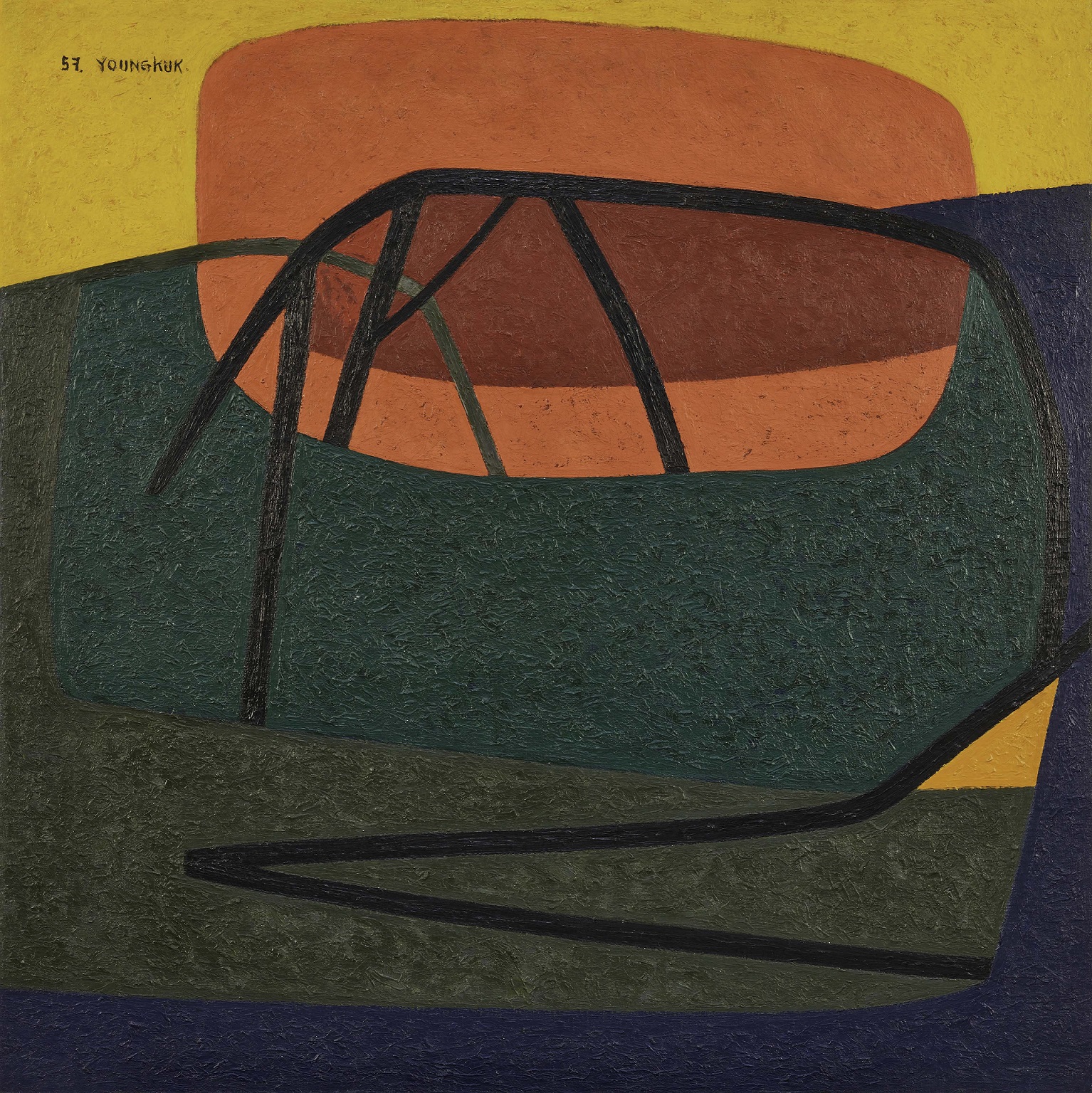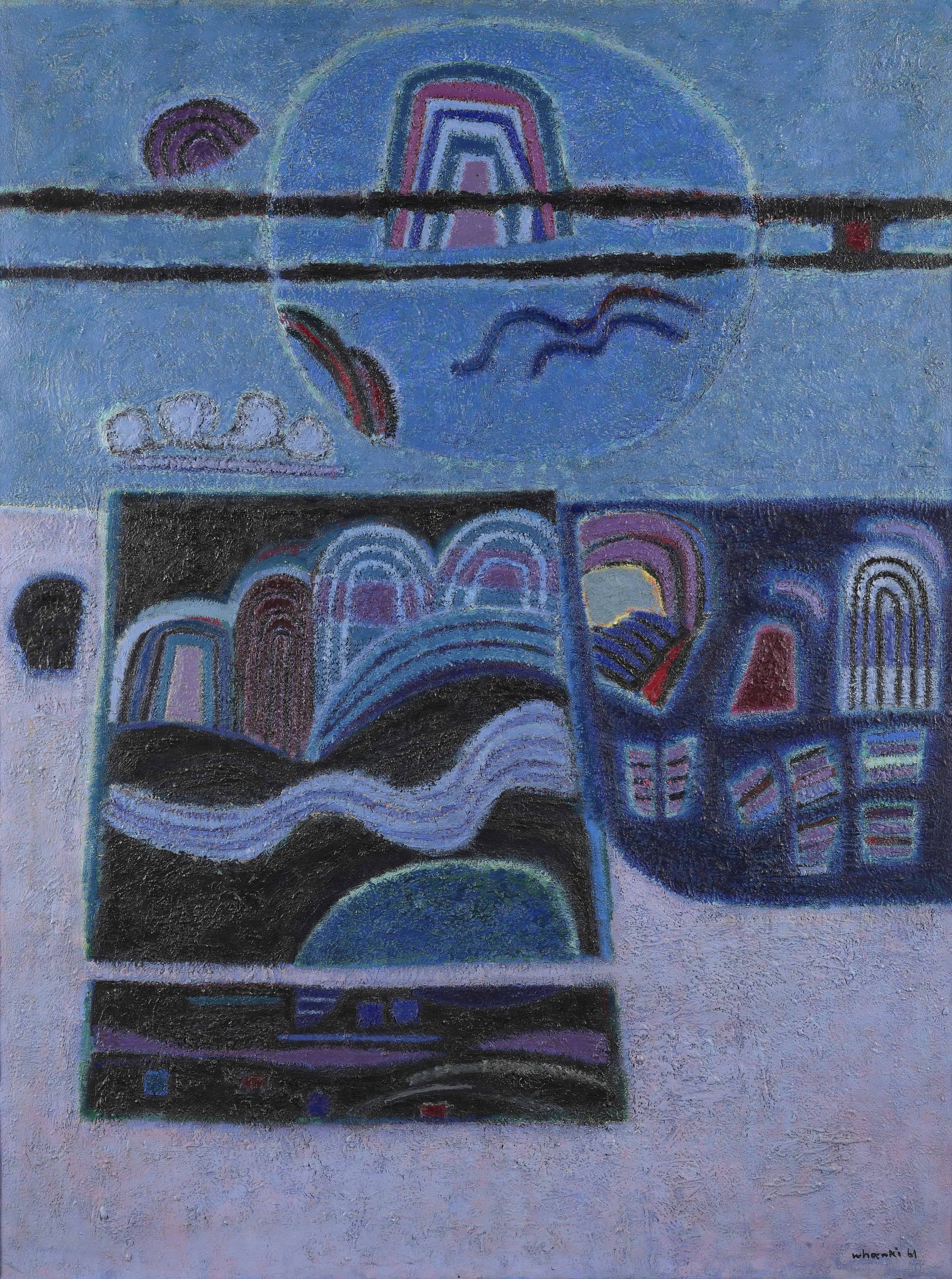Lee Kyusang, Composition, Oil on canvas, 69.5x55.7cm. MMCA collection
Lee Kyusang
* Source: Multilingual Glossary of Korean Art. Korea Arts Management Service
Related
-

New Realism Group
The New Realism Group [Sinsasilpa] was a group of abstract artists, such as Kim Whanki, Yoo Youngkuk, and Lee Kyusang, who, through their work sought to represent the conceptualization of a pure Plasticism. One of the most influential groups in Korean modern art, the name “New Realism Group” was created by Kim Whanki. This originated from his foundational idea that the artists of the group should pursue new types of realistic painting. Since they considered that all forms, including abstract ones, ultimately belong to experiential reality, the ambition of the group was to contribute to the perception of a “new formation of reality”. Their inaugural exhibition was held at Hwashin Department Store's gallery from December 7th to 14th, 1948. Chang Ucchin then joined the group for the second exhibition, followed by Lee Jungseop and Paek Youngsu for the third. They disbanded the group after the third exhibition, which was staged at the temporarily relocated National Museum in Busan from May 26th to June 4th, 1953. The works of the New Realism Group navigated a path between figuration and non-figuration through the deployment of abstract expressionist idioms, while also making use of visual elements taken from nature, everyday life, and real-life materials. The New Realism Group were pioneers of a new style of Korean abstract art, one which they realized as an attempt to create a new artistic perspective that could exist outside the pervasive right-left ideological struggle that defined the politically, economically, socially, and culturally unstable Cold War period of Korea. A retrospective exhibition for the group was held at the Won Gallery from September 23rd to 30th, 1978, and a sixtieth commemorative exhibition was held at the Whanki Museum from November 9th in 2007 to January 13th, 2008.
-

Modern Art Association
The Modern Art Association was an art association established on January 5th, 1957 by several veteran artists. They aimed to establish a wholesome art culture in Korea after a dispute over the 1956 National Art Exhibition (Gukjeon). The five founding members were Lee Kyusang, Park Kosuk, Yoo Youngkuk, Han Mook, and Hwang Yeomsoo. Other artists, including Chung Jeumsik, Lim Wangyu, Chung Kyu, Moon Shin, Kim Gyeong, and Chun Kyungja, joined after the third exhibition. In Sinmisul magazine, they explained that the group “aims to solve the problems of contemporary painting and to maintain independence as the avant-garde of the movement.” They hosted their first exhibition in April 1957, followed by exhibitions in November 1957, June 1958, November 1958, December 1959, and their final exhibition in July 1960. There was a dispute among members regarding participation in the Invitational Exhibition of Contemporary Artists sponsored by Chosun Ilbo in 1959, and the group was disbanded after Han Mook and Moon Shin left for France. The group played a pivotal role in the 1950s Korean art community by advocating for an avant-garde spirit to drive the modern art community.
-

Contemporary Art Exhibit
An exhibition held from 1957 to 1969 by Chosun Ilbo. Two artists, Kim Byungki and Kim Youngjoo, and a reporter at the Chosun Ilbo Culture Desk, Han Bongdeok, participated in the establishment. The invitational united independent artists that resisted the authority of the establishment and triggered the emergence of Anti-academicist exhibition, minjeon. The invitational also contributed to the spread of Informel Abstractionism in the late 1950s and early 1960s. The first exhibition, held in 1957, featured 20 Western-style artists, and from the fifth exhibition, held in 1961, the invitational accepted submissions from not yet established artists. In the following year, 11 artists were invited from overseas to take part in an international exhibition, and in 1963, the invitation of an Academicist artist raised controversy. The invitational was discontinued after this 13th exhibition in 1963.
Find More
-

Yoo Youngkuk
Yoo Youngkuk (1916-2002) was born in Uljin, Gyeongsangbuk-do. He graduated from Uljin Elementary School and attended Gyeongseon Teachers College from 1931 to 1934. He moved to Japan in 1935 and graduated from the Tokyo Culture School in 1938. He submitted his work to the Yanghwa Art Coterie Exhibition and won a grand prize for his radical and avant-garde constructive abstract art in the Free Artists Association Exhibition in 1938. He was then recommended as a new member. After independence, he participated in the New Realism Group Exhibition, the Modern Art Association Exhibition, the 1950 Art Association [Osimnyeon misul hyeophoe] Exhibition, the Contemporary Art Exhibit sponsored by Chosun Ilbo, and Sinsanghoe. He worked as an art professor at Seoul National University from 1948 to 1950 and at Hongik University from 1966 to 1970. He was one of the first abstract artists in Korea. While in Japan he pursued the creation of an absolute form of abstraction. Then, back in Korea after independence, he switched to using constructive and emotional color in his abstract compositions to represent the sublime character of nature.
-

Kim Whanki
Kim Whanki (1913-1974, pen name Suhwa) was born in Sinan, Jeollanamdo, and his family origin was from Gimhae. He studied at the Department of Fine Arts at Nihon University, Tokyo, Japan from 1933 to 1936. He joined the Avant-Garde Western Art Institute in 1934 and submitted his work to Avant-Garde art associations, such as the Second Division Exhibition Nikaten (Nika Art Exhibition) and the Exhibition of the Free Artists Association (Jiyu Bijutsuka Kyokai). After independence, he organized the New Realism Group and worked as a professor in the Department of Fine Art at Seoul National University (1946-1950) and Hongik University (1952-55). He lived in Paris from 1956 to 1959, and after his return, he became a professor and later the Dean of the Fine Art College at Hongik University (1959-1963). He participated in the seventh Sao Paulo Biennale and won an honorary award, and then moved to New York. He abruptly passed away while having a solo exhibition at Poindexter Gallery, New York, ironically when his career in the US was at its peak. As a pioneer of Korean abstract art, he started by working in geometric abstraction and moved on to semi-abstract work that featured natural motifs such as the mountain, the moon, and the river. After moving to the U.S., he returned to abstraction with his so-called "dot paintings." His painting 16-Ⅳ-70 #166 Where, in What Form, Shall We Meet Again? (1970), was awarded a grand prize at the Korean Art Grand Award Exhibition and has inspired many contemporary Korean artists. His work Rondo (1938) was selected as No. 535 within the national Registered Cultural Properties.






